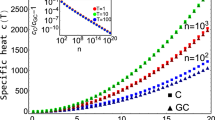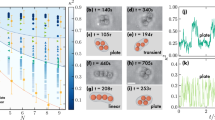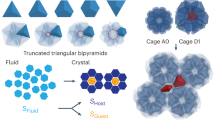Abstract
Burgeoning experimental and simulation activity seeks to understand the existence of self-assembled colloidal structures that are not close-packed1,2,3,4,5,6,7,8,9. Here we describe an analytical theory based on lattice dynamics and supported by experiments that reveals the fundamental role entropy can play in stabilizing open lattices. The entropy we consider is associated with the rotational and vibrational modes unique to colloids interacting through extended attractive patches10. The theory makes predictions of the implied temperature, pressure and patch-size dependence of the phase diagram of open and close-packed structures. More generally, it provides guidance for the conditions at which targeted patchy colloidal assemblies in two and three dimensions are stable, thus overcoming the difficulty in exploring by experiment or simulation the full range of conceivable parameters.
This is a preview of subscription content, access via your institution
Access options
Subscribe to this journal
Receive 12 print issues and online access
$259.00 per year
only $21.58 per issue
Buy this article
- Purchase on Springer Link
- Instant access to full article PDF
Prices may be subject to local taxes which are calculated during checkout




Similar content being viewed by others
References
Antlanger, M., Doppelbauer, G. & Kahl, G. On the stability of Archimedean tilings formed by patchy particles. J. Phys. Condens. Matter 23, 404206 (2011).
Torquato, S. Inverse optimization techniques for targeted self-assembly. Soft Matter 5, 1157–1173 (2009).
Cohn, H. & Kumar, A. Algorithmic design of self-assembling structures. Proc. Natl Acad. Sci. USA 106, 9570–9575 (2009).
Edlund, E., Lindgren, O. & Jacobi, M. N. Novel self-assembled morphologies from isotropic interactions. Phys. Rev. Lett. 107, 085501 (2011).
Chen, Q., Bae, S. & Granick, S. Directed self-assembly of a colloidal kagome lattice. Nature 469, 381–384 (2011).
Chen, Q. et al. Triblock colloids for directed self-assembly. J. Am. Chem. Soc. 133, 7725–7727 (2011).
Romano, F. & Sciortino, F. Two-dimensional assembly of triblock Janus particles into crystal phases in the two bond per patch limit. Soft Matter 7, 5799–5804 (2011).
Romano, F. & Sciortino, F. Patterning symmetry in the rational design of colloidal crystals. Nature Commun. 3, 975 (2012).
Khalil, K. S. et al. Binary colloidal structures assembled through Ising interactions. Nature Commun. 3, 794 (2012).
Glotzer, S. C. & Solomon, M. J. Anisotropy of building blocks and their assembly into complex structures. Nature Mater. 6, 557–562 (2007).
Galisteo-López, J. F. et al. Self-assembled photonic structures. Adv. Mater. 23, 30–69 (2011).
Su, B-L., Sanchez, C. & Yang, X-Y. Hierarchically Structured Porous Materials: From Nanoscience to Catalysis, Separation, Optics, Energy, and Life Science 55–129 (Wiley, 2012).
Maxwell, J. C. On the calculation of the equilibrium and stiffness of frames. Phil. Mag. 27, 294 (1864).
Souslov, A., Liu, A. J. & Lubensky, T. C. Elasticity and response in nearly isostatic periodic lattices. Phys. Rev. Lett. 103, 205503 (2009).
Kapko, V., Treacy, M., Thorpe, M. & Guest, S. On the collapse of locally isostatic networks. Proc. R. Soc. Lond. A 465, 3517 (2009).
Hammonds, K. D., Dove, M. T., Giddy, A. P., Heine, V. & Winkler, B. Rigid-unit phonon modes and structural phase transitions in framework silicates. Am. Mineral. 81, 1057–1079 (1996).
Sun, K., Souslov, A., Mao, X. & Lubensky, T. C. Surface phonons, elastic response, and conformational invariance in twisted kagome lattice. Proc. Natl Acad. Sci. USA 31, 12369–12374 (2012).
Guest, S. D. & Hutchinson, J. W. On the determinacy of repetitive structures. J. Mech. Phys. Solids 51, 383–391 (2003).
Yodh, A. et al. Entropically driven self-assembly and interaction in suspension. Phils. Trans. R. Soc. Lond. A 359, 921–937 (2001).
Meng, G. et al. The free-energy landscape of clusters of attractive hard spheres. Science 327, 560–563 (2010).
Chen, Q. et al. Supracolloidal reaction kinetics of Janus spheres. Science 331, 199–202 (2011).
Kern, N. & Frenkel, D. Fluid–fluid coexistence in colloidal systems with short-ranged strongly directional attraction. J. Chem. Phys. 118, 9882–9889 (2003).
Born, M. & Huang, K. Dynamic Theory of Crystal Lattices (Clarendon, 1998).
Keim, P., Maret, G., Herz, U. & von Grünberg, H. H. Harmonic lattice behavior of two-dimensional colloidal crystals. Phys. Rev. Lett. 92, 215504 (2004).
Ghosh, A. et al. Density of states of colloidal glasses. Phys. Rev. Lett. 104, 248305 (2010).
Ho, K. M., Chan, C. T. & Soukoulis, C. M. Existence of a photonic band gap in periodic dielectric structures. Phys. Rev. Lett. 65, 3152–3155 (1990).
Romano, F., Sanz, E. & Sciortino, F. Role of the range in the fluid-crystal coexistence for a patchy particle model. J. Phys. Chem. B 113, 15133 (2009).
Mao, X. & Lubensky, T. C. Coherent potential approximation of random nearly isostatic kagome lattice. Phys. Rev. E 83, 011111 (2011).
Acknowledgements
X.M. was supported by NSF under grant DMR-1104707. Q.C. and S.G. were supported by the US Department of Energy Division of Materials Science, under award number DE-FG02-07ER46471 through the Frederick Seitz Materials Research Laboratory at the University of Illinois at Urbana-Champaign. For equipment, we acknowledge the National Science Foundation, CBET-0853737. We thank K. Chen for help with particle tracking, and J. Whitmer and T. C. Lubensky for useful discussions.
Author information
Authors and Affiliations
Contributions
X.M. and Q.C. initiated this work; X.M. developed the theory and did calculations based on the theory; Q.C. and S.G. designed and performed the experiment; X.M., Q.C. and S.G. wrote the paper.
Corresponding author
Ethics declarations
Competing interests
The authors declare no competing financial interests.
Supplementary information
Supplementary Information
Supplementary Information (PDF 416 kb)
Rights and permissions
About this article
Cite this article
Mao, X., Chen, Q. & Granick, S. Entropy favours open colloidal lattices. Nature Mater 12, 217–222 (2013). https://doi.org/10.1038/nmat3496
Received:
Accepted:
Published:
Issue Date:
DOI: https://doi.org/10.1038/nmat3496
This article is cited by
-
Entropy compartmentalization stabilizes open host–guest colloidal clathrates
Nature Chemistry (2023)
-
Clusters formed by dumbbell-like one-patch particles confined in thin systems
Scientific Reports (2021)
-
Crystal engineering with DNA
Nature Reviews Materials (2019)
-
A universal state and its relaxation mechanisms of long-range interacting polygons
Nature Communications (2019)
-
Active generation and magnetic actuation of microrobotic swarms in bio-fluids
Nature Communications (2019)



